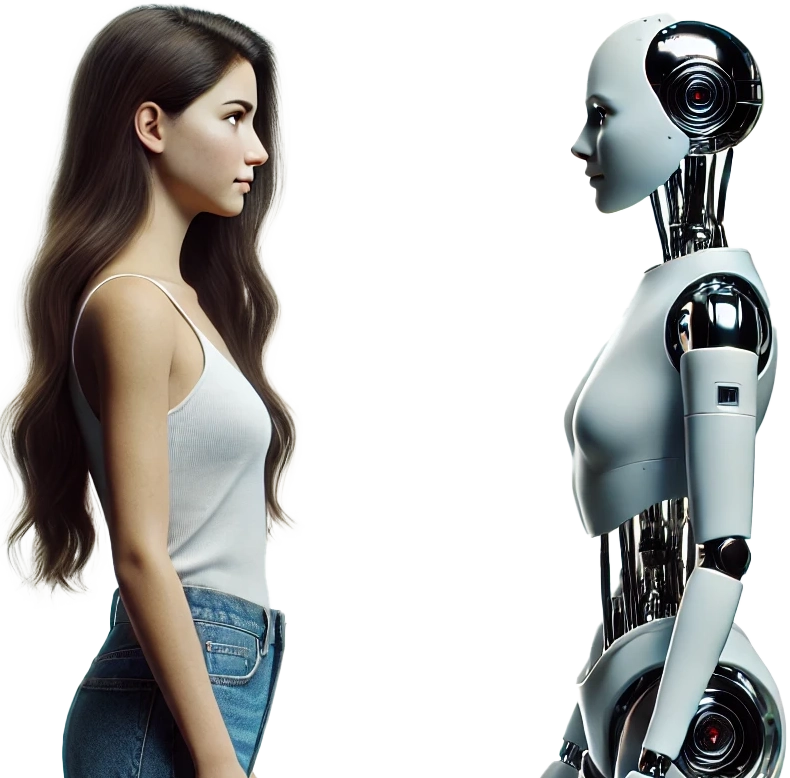"Die Maschinenethik arbeitet mit Künstlicher Intelligenz und Robotik zusammen. Sie bringt maschinelle Moral hervor und untersucht sie. Ausgangspunkt sind teilautonome und autonome Systeme, etwa selbstständig fahrende Autos, Serviceroboter, Kampfroboter und Chatbots. Dieses Handbuch liefert Grundlagen zur Maschinenethik, erkundet Anwendungsgebiete der Disziplin und stellt Prototypen moralischer Maschinen vor. Neben der Maschinenethik kommen Roboterethik und Rechtswissenschaft zu Wort." (Quelle: Springer-Information zum Buch)
"Soziale Roboter sind sensomotorische Maschinen, die für den Umgang mit Menschen oder Tieren geschaffen wurden. Sie können über fünf Dimensionen bestimmt werden, nämlich die Interaktion mit Lebewesen, die Kommunikation mit Lebewesen, die Nähe zu Lebewesen, die Abbildung von (Aspekten von) Lebewesen sowie – im Zentrum – den Nutzen für Lebewesen. Bei einem weiten Begriff können neben Hardwarerobotern auch Softwareroboter wie gewisse Chatbots, Voicebots (Sprachassistenten oder virtuelle Assistenten) und Social Bots dazu zählen. Die Disziplin, die soziale Roboter – ob als Spielzeugroboter, als Serviceroboter (Pflegeroboter, Therapieroboter, Sexroboter, Sicherheitsroboter etc.) oder als Industrieroboter in der Art von Kooperations- und Kollaborationsrobotern (Co-Robots bzw. Cobots) – erforscht und hervorbringt, ist die soziale Robotik. Das Buch schafft Grundlagen in technikwissenschaftlicher, wirtschaftswissenschaftlicher, philosophischer, psychologischer und soziologischer Hinsicht. Es stellt dar, was soziale Roboter ausmacht, wie sie gebaut und programmiert werden, welche Anwendungsmöglichkeiten existieren und welche Herausforderungen sich ergeben." (Quelle: Springer-Information zum Buch)
"Sexroboter sind ein Thema, das die Medien mit Vorliebe behandeln und die Gesellschaft spaltet. Es gibt einige Sexroboter wie Emma oder Harmony. Viel verbreiteter sind allerdings Liebespuppen mit überzeugender Haut und auswechselbaren Körperöffnungen. Sie finden sich in zahlreichen Bordellen und können problemlos bei Amazon und Co. bestellt werden. Zwischen Liebespuppen und Sexrobotern sind die Grenzen fließend. Sobald Liebespuppen sprechen können oder Kameras zur Erfassung haben, werden sie zu Sexrobotern. Weiter entwickelte Sexroboter haben mimische oder gestische Fähigkeiten. Das Buch erklärt Grundbegriffe, technische Möglichkeiten und künstlerische Ansätze, es diskutiert medizinische, psychologische und philosophische Herausforderungen. Dabei wird vor allem vom tatsächlichen Stand ausgegangen, und es wird auch die Situation in Bordellen erforscht (einschl. des Umstands, dass dort teilweise Fantasyfiguren zur Verfügung stehen). In einem Kapitel wird auf Zukunftsszenarien eingegangen." (Quelle: Springer-Information zum Buch)
"Dieses Open-Access-Buch bündelt technische, wirtschaftliche, medizinische und ethische Reflexionen über Pflegeroboter. Pflegeroboter, im Moment noch mehrheitlich Prototypen, unterstützen oder ersetzen menschliche Pflegekräfte bzw. Betreuer. Sie bringen Kranken und Alten die benötigten Medikamente und Nahrungsmittel, helfen beim Hinlegen und Aufrichten oder alarmieren den Notdienst. Vorteile von Pflegerobotern sind durchgehende Verwendbarkeit und gleichbleibende Qualität der Dienstleistung. Nachteile sind Kostenintensität (bei möglicher Amortisation) und Komplexität der Anforderungen. Unter der wissenschaftlichen Leitung von Prof. Dr. Oliver Bendel trafen sich im September 2017 Vertreter verschiedener wissenschaftlicher Disziplinen im Rahmen eines Ladenburger Diskurses der Daimler und Benz Stiftung, um über den aktuellen und künftigen Einsatz von Pflegerobotern zu sprechen und Forschungspotenziale zu identifizieren. Die Autoren gehen in ihren Beiträgen auch Fragen aus Wirtschafts-, Medizin- und Informationsethik nach ..." (Quelle: Springer-Information zum Buch)
"Vom 'Anthropozän' über die 'Marsstation' bis hin zur 'Weltraumwirtschaft': Im Zusammenhang mit dem Weltraum gibt es unzählige Fachtermini. Dieses kompakte Lexikon bietet einen fundierten Überblick über zentrale Begriffe der Raumfahrt, ergänzt um aktuelle Entwicklungen in Technik, Wissenschaft und Gesellschaft. Es richtet sich an alle, die sich für den Weltraum interessieren – ob aus naturwissenschaftlicher, technischer, wirtschaftlicher, ethischer oder kultureller Perspektive. Der Autor verbindet seine langjährige Erfahrung in den Bereichen Künstliche Intelligenz, Robotik und Ethik mit seiner frühen Faszination für das Weltall. Neben klassischen Einträgen wie 'Astronomie', 'Galaxie' oder 'Raumstation' finden sich Themen wie 'Weltraumkunst', 'Robotische Vierbeiner' und 'Generative KI'. Dabei werden nicht nur Fakten vermittelt, sondern auch Zusammenhänge aufgezeigt und Denkanstöße gegeben. Der Band versteht sich als Beitrag zur Orientierung in einem sich rasant entwickelnden Feld – und als Einladung, den Weltraum aus neuen Blickwinkeln zu betrachten." (Quelle: Springer-Information zum Buch)
"Von A wie Alignment bis Z wie Zensur: Dieses Nachschlagewerk bietet in mehr als 300 Einträgen einen Überblick über das Thema der generativen KI. Es klärt zahlreiche Fachbegriffe, stellt Anwendungsbereiche vor und diskutiert aktuelle Fragestellungen. Dabei spielen neben technischen und wirtschaftlichen Fragen insbesondere ethische und ästhetische eine Rolle. So wird nach der Schönheit von Artefakten gefragt, es wird die Stellung von Bildern zwischen Kunst und Kitsch ausgeleuchtet, und es wird eine Bias-Diskussion zu Text- und Bildgeneratoren geführt. Insgesamt steht der Nutzen der generativen KI im Vordergrund, und die Freude und Lust, sie zu benutzen. Das Buch richtet sich an ein breites Publikum, etwa Journalisten, Politiker und Bürger, aber auch an Wissenschaftler aller Bereiche." (Quelle: Springer-Information zum Buch)
"Das vorliegende Nachschlagewerk sammelt und erläutert Begriffe rund um Soziale Robotik und Automatisierung. Es ist für alle geeignet, die einen schnellen Einstieg in das Gebiet suchen und sich besonders für Fragen des Zusammenspiels von Mensch und Maschine sowie Fragen der Ethik in diesem Bereich interessieren. In über 300 übersichtlichen Beiträgen werden die Grundlagen und Entwicklungen leicht verständlich erläutert." (Quelle: Springer-Information zum Buch)
"Vom 'Altruismus' über die 'Filter Bubble' bis hin zum 'Whistleblowing': Die Sprache der Informationsethik zeichnet sich durch unzählige Fachtermini und Anglizismen aus. Das vorliegende Nachschlagewerk eignet sich für den ersten schnellen Überblick. In 400 übersichtlichen Beiträgen werden die Grundlagen erläutert. Die Erklärungen sind verständlich formuliert und bieten Basiswissen für alle, die einen schnellen Einstieg in die Grundfragen der Informationsgesellschaft suchen und sich für Informationsethik interessieren." (Quelle: Springer-Information zum Buch)
"Von 'Big Data' über die 'Künstliche Intelligenz' bis hin zur 'Sozialen Robotik': Im Kontext der Digitalisierung gibt es unzählige Fachtermini. Das vorliegende Nachschlagewerk ist für alle geeignet, die einen schnellen Einstieg in das Gebiet der Digitalisierung suchen und sich für Fragen der Ethik interessieren. In 450 übersichtlichen Beiträgen werden die Grundlagen und Entwicklungen leicht verständlich erlätert." (Quelle: Springer-Information zum Buch)
Von 'Aktivist' über 'Nachhaltigkeit' bis zu 'Zensur': Im Kontext der Wirtschaftsethik gibt es unzählige Fachtermini und Abkürzungen. Das vorliegende Nachschlagewerk eignet sich für den ersten schnellen Überblick. Anhand von 110 übersichtlichen Schlüsselbegriffen werden die Grundlagen erläutert. Die Erklärungen sind kompakt und verständlich formuliert und bieten Basiswissen für alle, die einen schnellen Einstieg in das Thema Wirtschaftsethik suchen, einzelne Begriffe nachschlagen oder ihr vorhandenes Wissen auffrischen möchten." (Quelle: Springer-Information zum Buch)
"This book constitutes the refereed proceedings of the Third International Conference on Love and Sex with Robots, LSR 2017, held in December 2017, in London, UK. The 12 revised papers presented together with 2 keynotes were carefully reviewed and selected from a total of 83 submissions. One of the biggest challenges of the Love and Sex with Robots conference is to engage a wider scientific community in the discussions of the multifaceted topic, which has only recently established itself as an academic research topic within, but not limited to, the disciplines of artificial intelligence, human-computer interaction, robotics, biomedical science and robot ethics etc." (Quelle: Springer-Information zum Buch) Enthalten ist ein Beitrag von Oliver Bendel mit dem Titel "SSML for Sex Robots".
"This book constitutes the refereed proceedings of the Second International Conference on Love and Sex with Robots 2016 in December 2016, in London, UK. The 12 revised papers presented together with 1 keynote (David Levy, Emma Yann Zhang, Oliver Bendel and others; Anm. d. Red.) were carefully reviewed and selected from a total of 38 submissions. The papers of the Second International Conference have been accepted and reviewed in 2015 but could not be presented as there was no conference in 2015 but at the conference in 2016. The topics of the conferences were as follows: robot emotions, humanoid robots, clone robots, entertainment robots, robot personalities, teledildonics, intelligent electronic sex hardware, gender approaches, affective approaches, psychological approaches, sociological approaches, roboethics, and philosophical approaches." (Quelle: Springer-Information zum Buch) Enthalten ist ein Beitrag von Oliver Bendel mit dem Titel "Sex Robots from the Perspective of Machine Ethics".
"The essays in this book, written by researchers from both humanities and science (Tatjana Kochetkova, Oliver Bendel, Mark R. Waser, Susan Leigh Anderson, Michael Anderson and others; Anm. d. Red.), describe various theoretical and experimental approaches to adding medical ethics to a machine, what design features are necessary in order to achieve this, philosophical and practical questions concerning justice, rights, decision-making and responsibility in medical contexts, and accurately modeling essential physician-machine-patient relationships." (Quelle: Springer-Information zum Buch) Enthalten ist ein Beitrag von Oliver Bendel mit dem Titel "Surgical, Therapeutic, Nursing and Sex Robots in Machine and Information Ethics".
"Der digitale Wandel erfasst immer mehr Bereiche unseres Lebens und wirft dadurch viele neue ethische Fragestellungen auf. Mit dem Buch '3TH1CS' erforschen wir in konkreten Beiträgen, wo sich diese Fragen genau stellen und wie wir als Gesellschaft mit ihnen umgehen können oder sogar sollten. Die insgesamt 20 Beiträge stammen von ausgewählten Expertinnen und Experten, die zu den führenden Denkern in Europa, Asien und Amerika gehören. Sie beleuchten die Bereiche, in denen der digitale Wandel eine Herausforderung für bestehende moralische Konventionen darstellt oder sogar ein Umdenken erfordert." (Quelle: Information von iRights.Lab) Enthalten ist ein Beitrag von Oliver Bendel mit dem Titel "Sexroboter und Robotersex aus Sicht der Ethik".
"Das Buch betrachtet den Einsatz der Robotik in Gesundheit, Wirtschafts- und Arbeitswelt aus interdisziplinärer Perspektive. Immer eigenständigere Roboter halten Einzug in unseren Alltag. Bereits heute übernehmen sie eine Vielzahl von Aufgaben z.B. in der produzierenden Industrie oder der Medizin. Diese maschinellen Systeme agieren in atemberaubendem Tempo immer unabhängiger von menschlicher Steuerung. In zunehmendem Maße sind sie in der Lage, auch komplexere Schlussfolgerungen zu ziehen. All dies wirft eine Vielzahl ethischer und juristischer Fragen auf: Wie verändern automatisierte Systeme unser Leben und Selbstverständnis? Vor welchen Herausforderungen stehen Arbeitswelt, öffentlicher Raum und Pflege? Experten aus Wissenschaft und Politik beleuchten diese und weitere Fragen innerhalb des vorliegenden Bandes." (Quelle: Springer-Information zum Buch) Enthalten ist ein Beitrag von Oliver Bendel mit dem Titel "Die programmierte Moral".
"Im Kontext der Industrie 4.0 sind ein wachsender Wettbewerbsdruck, immer größere Anforderungen an Flexibilität und Qualität und immer höhere Ansprüche der Stakeholder wahrnehmbar. In der bekannten Situation des demographischen Wandels entstehen zunehmend neue Assistenzsysteme, insbesondere in der Mensch-Roboter-Kollaboration (MRK). Diese Systeme arbeiten nicht mehr isoliert hinter Zäunen, sondern Hand in Hand mit den Menschen. Sie sollen den Menschen bei monotonen oder kraftraubenden Arbeiten unterstützen oder entlasten. Durch die direkte Zusammenarbeit von Mensch und Maschine rücken Arbeitssicherheit und Ergonomie zunehmend in den Fokus. Klärungsbedarf gibt es bei der Gestaltung von MRK-Arbeitsplätzen und bei der Akzeptanz dieser Arbeitsplätze. Auch neue Aufgabenfelder sind im Gespräch, die sich z.B. in Pflege und Medizin erschließen lassen. Arbeitspsychologie und Human Factors bekommen in der roboterbasierten Automatisierung eine neue, wichtige Bedeutung. Zudem stellt sich die ethische Frage, ob diese neuen Roboter auf längere Sicht den Menschen entlasten oder ersetzen." (Quelle: Springer-Information zum Buch) Enthalten ist ein Beitrag von Oliver Bendel mit dem Titel "Die Maschine an meiner Seite: Philosophische Betrachtungen zur Mensch-Roboter-Kollaboration".
"Using an interdisciplinary approach, this book explores the emerging topics and rapid technological developments of robotics and artificial intelligence through the lens of the evolving role of sex robots, and how they should best be designed to serve human needs. An international panel of authors provides the most up-to-date, evidence-based empirical research on the potential sexual applications of artificial intelligence. Early chapters discuss the objections to sexual activity with robots while also providing a counterargument to each objection. Subsequent chapters present the implications of robot sex as well as the security and data privacy issues associated with sexual interactions with artificial intelligence. The book concludes with a chapter highlighting the importance of a scientific, multidisciplinary approach to the study of human - robot sexuality." (Quelle: Springer-Information zum Buch) Enthalten ist ein Beitrag von Oliver Bendel mit dem Titel "Hologram Girl".
"Das Handbuch bietet einen Überblick über die technischen, historischen, sozialen, medialen, kulturwissenschaftlichen und technikphilosophischen Dimensionen verschiedener Typen von Mensch-Maschine-Interaktion sowie über deren ethische Implikationen. Dabei werden zum einen wissenshistorische Analysen der Diskurse in Philosophie, Literatur und Technik sowie ihrer medialen, apparativen und literalen Praktiken von ca. 1870 bis in die Gegenwart verfolgt (Historischer Teil). Zum anderen wird das komplexe Verhältnis von Menschen und Maschinen anhand von zentralen Begriffs- und Problemfeldern dargestellt und kritisch befragt (Systematischer Teil)." (Quelle: Springer-Information zum Buch) Enthalten ist ein Beitrag von Oliver Bendel mit dem Titel "Die Maschinenethik als neues interdisziplinäres Forschungsfeld".
"Wenn digitale Technologien wie künstliche Intelligenz, Blockchain und Robotik auf die Medizin treffen, entstehen zwangsläufig ethische Fragestellungen. Diese lassen sich nicht ohne Weiteres mit medizinisch-technologischen, rechtlichen oder ökonomischen Argumenten allein beantworten. Neue Themenfelder wie die sich wandelnde Rolle der Patienten, die neue Verantwortung von Ärzten und Pflegenden, neue digitale Möglichkeiten in der Medizin, Smart Hospitals im Klinikalltag, die gesellschaftliche Legitimität eines möglichen dritten Datengesundheitsmarktes, eine zukunftsfeste Ausbildungslandschaft für den Gesundheits-/Medizinbereich sowie die Grenzen der digitalen Forschung bedürfen einer kritischen und gleichzeitig thematisch breiten Auseinandersetzung mit ethischen Aspekten in der digitalen Gesundheitswirtschaft und Medizin. Dies ist nicht nur inhaltlich wichtig, sondern auch zeitkritisch, denn gerade dieser Sektor hat eine erhebliche globale Marktdynamik. Längst ist 'eHealth' i.w.S. keine Kerninnovation von klassischen Gesundheitsakteuren mehr. Es gehört vielmehr zum Tagesgeschäft der großen US-amerikanischen und chinesischen Game Changer wie Google, Apple, Microsoft, Facebook, Amazon, Netflix, Alibaba und Tencent. Die verantwortbare, aber auch wettbewerbsfähige Partizipation an diesen Entwicklungen ist vielleicht die drängendste Aufgabe fär die Akteure in Wissenschaft, Krankenversorgung, Gesundheitswirtschaft und Politik. Ausgewiesene Experten aus diesen Bereichen stellen sich daher im vorliegenden Werk den oft schwierigen Fragen, die sich auf dem Weg der Transformation zu einem B2B2C-Markt im Gesundheitswesen, der einer ethischen Betrachtung standhält, ergeben." (Quelle: MWV-Information zum Buch) Enthalten ist ein Beitrag von Oliver Bendel mit dem Titel "Ethische Überlegungen zu Pflegerobotern".
Oliver Bendel ist assoziierter Forscher der PECoG-Gruppe (Universität Potsdam).
Maik, ein 16-jähriger Junge, hat eine Drohne entwickelt, die einer Fliege gleicht und mit deren Hilfe er alles sehen kann, was er sehen will. Sein Plan ist, Prominente und Reiche auszuspionieren und, wenn er das ultimative Bild gefunden hat, zu erpressen. Nur seinem Tagebuch vertraut er sich an, einem digitalen Rekorder. Nancy, die früher als Mundmodell und für die Stasi gearbeitet hat, surft mit ihrer kleinen Maschine auf elektromagnetischen Wellen, bis sie auf Schallwellen trifft. Wie früher belauscht sie andere, aber ohne an verwanzte Räume gebunden zu sein – und nicht, um Böses zu schaffen, sondern um Böses zu verhindern. Maik und Nancy kommen über die ahnungslose Stadt. Sie wissen nichts voneinander, bis die Frau ein merkwürdiges Brummen hört. Fast eine Fliege. Aber eben nur fast. (Quelle: www.oliverbendel.net)
Anna Wede wird auf eine Professur an einer Schweizer Hochschule berufen. Sie liebt ihre Wohnung, von der aus sie auf einen mächtigen Berg blickt, sie ist fasziniert von der ins Hochtal gelegten Stadt. Nicht zum ersten Mal hält sie ihre Vorlesung zur künstlichen Kreatur, in der sie auf Ideen der Antike ebenso eingeht wie auf Agenten und Avatare der Gegenwart. Lydie ist eine aufmerksame und zielstrebige schweizerische Studentin. Ihre Einladung zum Weintrinken in einem Lokal schlägt Anna nicht ab. Sie nähern sich an, vor allem körperlich und äußerlich. Die Studentin könnte Annas Phantasie entsprungen sein. Aber ihre Macht über die Professorin ist real. (Quelle: www.oliverbendel.net)
Nelli ist 14. Sie und ihre Freundin Sara gehen ins Café, ins Kino, klauen in einer Boutique. Sie haben Cyber- und Telefonsex, langweilen sich auf Partys und begehen beinahe einen Raubüberfall auf offener Straße. Als Nelli den gleichaltrigen Robert kennenlernt, spürt sie so etwas wie Glück - aber zur gleichen Zeit entgleitet ihr das Leben. Sie und Sara verabreden sich im Chat mit einem Mann, der sie zu Hause fast vergewaltigt. Als Nelli schließlich Robert Gewalt antut, scheint dies für beide das Ende zu sein. Und doch geht es irgendwie weiter, ganz anders, als man vermutet. (Quelle: www.oliverbendel.net)
Handyhaiku oder - in anderer Schreibweise - Handyhaikus sind Haikus über das Handy bzw. für das Handy. Sie können auf dem Handy gespeichert und gelesen und über das mobile Gerät verschickt werden. Oliver Bendels Handyhaikus erzählen von unserer technisierten und medialisierten Zeit, fangen unsere mobile Welt ein, lassen künstliche Kreaturen und Maschinenmenschen auftauchen und spiegeln Figuren seiner Romane wider. Sie knüpfen an eine Tradition an und erfinden ihre eigene. (Quelle: "handyhaiku")
"Seit Sommer 2020 ist mit dem JAB Code des Fraunhofer SIT ein 3D-Code verfügbar, der eine höhere Speicherkapazität als ein 2D-Code hat. Möglich macht das eben die dritte Dimension, die Farbe. Die vorliegenden Gedichte, entstanden zwischen 2013 und 2015, wurden Anfang Juli 2020 über https://jabcode.org umgewandelt und können über https://jabcode.org auch zurückverwandelt werden, in für Menschen lesbaren Text. Am besten eignet sich ein Smartphone. Es muss keine App heruntergeladen werden. Es genügt, den Browser zu öffnen, die genannte Adresse einzugeben und dann der Verwendung der Kamera zuzustimmen. Sie können aber auch einen beliebigen Computer nehmen, das Bild im Dokument abspeichern und dann hochladen." (Quelle: "Die Astronautin")



